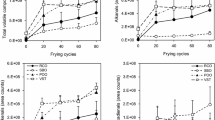Abstract
This study aimed to investigate the effect of cold plasma in the oxygen and nitrogen atmospheres on oilseeds of sunflower and sesame, especially their physicochemical properties of extracted oils. Treated oilseeds were stored under controlled laboratory conditions, at 38% relative humidity and 20 °C. After 0, 7, 15, 21, and 30 days of storage, the oilseeds were subjected to oil extraction by Soxhlet. The results showed that free fatty acids and saturated fatty acid content in extracted oils increased even during 30 days storage at 20 °C by higher treatment times (30 min) in all oilseeds samples. However, after 15 min cold plasma treatment, unsaturated fatty acid content increased about 3.9 and 5% in sunflower and sesame oils, respectively. However, it can be decreased severely by 30 days storage of oilseeds with more prolonged treatment time (P > 0.05). Polyunsaturated fatty acids were more sensitive to plasma reactive species, decomposed with higher rates, and reduced iodine value in both oils. The saponification value of both oils increased after plasma treatment and during the storage time. The total phenolic compound in both oils drastically decreased as the exposure and storage times increased, mainly when oxygen gas was applied (P < 0.05). Accordingly, antioxidant activity and Induction period decreased in both samples. Cold plasma treatment significantly changed all color parameters (P < 0.05). Non-thermal plasma treatment increased red color intensity, browning index, and general discoloration. However, yellow color intensity, whiteness, and the color saturation degree decreased in plasma-treated samples. An increase in the treatment time made the effect more pronounced and reduced the shelf life of oils. The changes in the initial products of oxidation and induction period of the treated oil samples showed that cold plasma, regardless of the oilseed and gas used, can significantly intensify oxidation.






Similar content being viewed by others
References
H. Deeth, C. Fitz-Gerald, Lipolytic enzymes and hydrolytic rancidity, in Advanced Dairy Chemistry, Lipids, vol. 2, ed. by P. Fox, P. McSweeney (Springer, Boston, 2006), pp. 481–556
I. Albertos, A. Martín-Diana, P. Cullen, B. Tiwari, S. Ojha, P. Bourke, C. Álvarez, D. Rico, Innov. Food Sci Emerg. Technol. 44, 117–122 (2017)
A. Amanpour, J. Vandamme, S. Polat, H. Kelebek, J. Van Durme, S. Selli, Innov. Food Sci Emerg. Technol. 54, 123–131 (2019)
J.-S. Kim, E.-J. Lee, E.H. Choi, Y.-J. Kim, Innov. Food Sci Emerg. Technol. 22, 124–130 (2014)
H. Na, C. Mok, J. Lee, Food Chem. 302, 125306 (2020)
C. Sarangapani, D.R. Keogh, J. Dunne, P. Bourke, P. Cullen, Food chem. 235, 324–333 (2017)
M. Ahangari, Y. Ramezan, M.R. Khani, J. Food Process Eng. 44, 113593 (2021)
AOAC, Official Methods of Analysis (AOAC International, Washington, D.C., 2006)
S. Hosseini, M. Gharachorloo, B.G. Tarzi, M. Ghavami, H. Bakhoda, J. Am. Oil Chem’. Soc. 92, 1717–1724 (2015)
A.S. Kashfi, Y. Ramezan, M.R. Khani, LWT 123, 109121 (2020)
P. Rodríguez-Bonilla, F. Gandía-Herrero, A. Matencio, F. García-Carmona, J.M. López-Nicolás, Food Anal. Methods 10, 2994–3000 (2017)
S. Hosseini, Y. Ramezan, S. Arab, J. Food Meas. Charact. 14, 3175–3183 (2020)
F. Grzegorzewski, J. Ehlbeck, O. Schlüter, L.W. Kroh, S. Rohn, LWT 44, 2285–2289 (2011)
M. Guderjan, P. Elez-Martínez, D. Knorr, Innov. Food Sci Emerg. Technol. 8, 55–62 (2007)
D. Chen, P. Peng, N. Zhou, Y. Cheng, M. Min, Y. Ma, Q. Mao, P. Chen, C. Chen, R. Ruan, Food chem. 290, 270–276 (2019)
H.-J. Kim, H.I. Yong, S. Park, W. Choe, C. Jo, Curr. Appl. Phys. 13, 1420–1425 (2013)
M. Gavahian, Y.-H. Chu, A.M. Khaneghah, F.J. Barba, N. Misra, Trends Food Sci. Technol. 77, 32–41 (2018)
M. Korachi, F. Ozen, N. Aslan, L. Vannini, M.E. Guerzoni, D. Gottardi, F.Y. Ekinci, Int. Dairy J. 42, 64–69 (2015)
J. Lee, M. Kim, E. Choe, Food Sci. Biotechnol. 16, 981–987 (2007)
P. Bourke, D. Ziuzina, D. Boehm, P.J. Cullen, K. Keener, Trends Biotechnol. 36, 615–626 (2018)
D.B. Min, J.M. Boff, Lipid oxidation of edible oil, in Food Lipids, Chemistry, Nutrition and Biotechnology. ed. by C.C. Akoh, D.B. Min (Marcel Dekker, New York, 2002), pp. 335–364
S. Choi, P. Puligundla, C. Mok, LWT 75, 323–328 (2017)
J. Van Durme, J. Vandamme, Food chem. 208, 185–191 (2016)
S. Iqbal, M. Bhanger, Food chem. 100, 246–254 (2007)
K. Mishra, H. Ojha, N.K. Chaudhury, Food chem. 130, 1036–1043 (2012)
C. López-Alarcón, A. Denicola, Anal. Chim. Acta 763, 1–10 (2013)
Author information
Authors and Affiliations
Corresponding author
Ethics declarations
Conflict of interest
The authors declare that they have no conflict of interest.
Research involving human and animal participants
The study does not involve any human or animal testing.
Additional information
Publisher's Note
Springer Nature remains neutral with regard to jurisdictional claims in published maps and institutional affiliations.
Rights and permissions
About this article
Cite this article
Afshar, S., Ramezan, Y. & Hosseini, S. Physical and chemical properties of oil extracted from sesame (Sesamum indicum L.) and sunflower (Helianthus annuus L.) seeds treated with cold plasma. Food Measure 16, 740–752 (2022). https://doi.org/10.1007/s11694-021-01205-0
Received:
Accepted:
Published:
Issue Date:
DOI: https://doi.org/10.1007/s11694-021-01205-0




